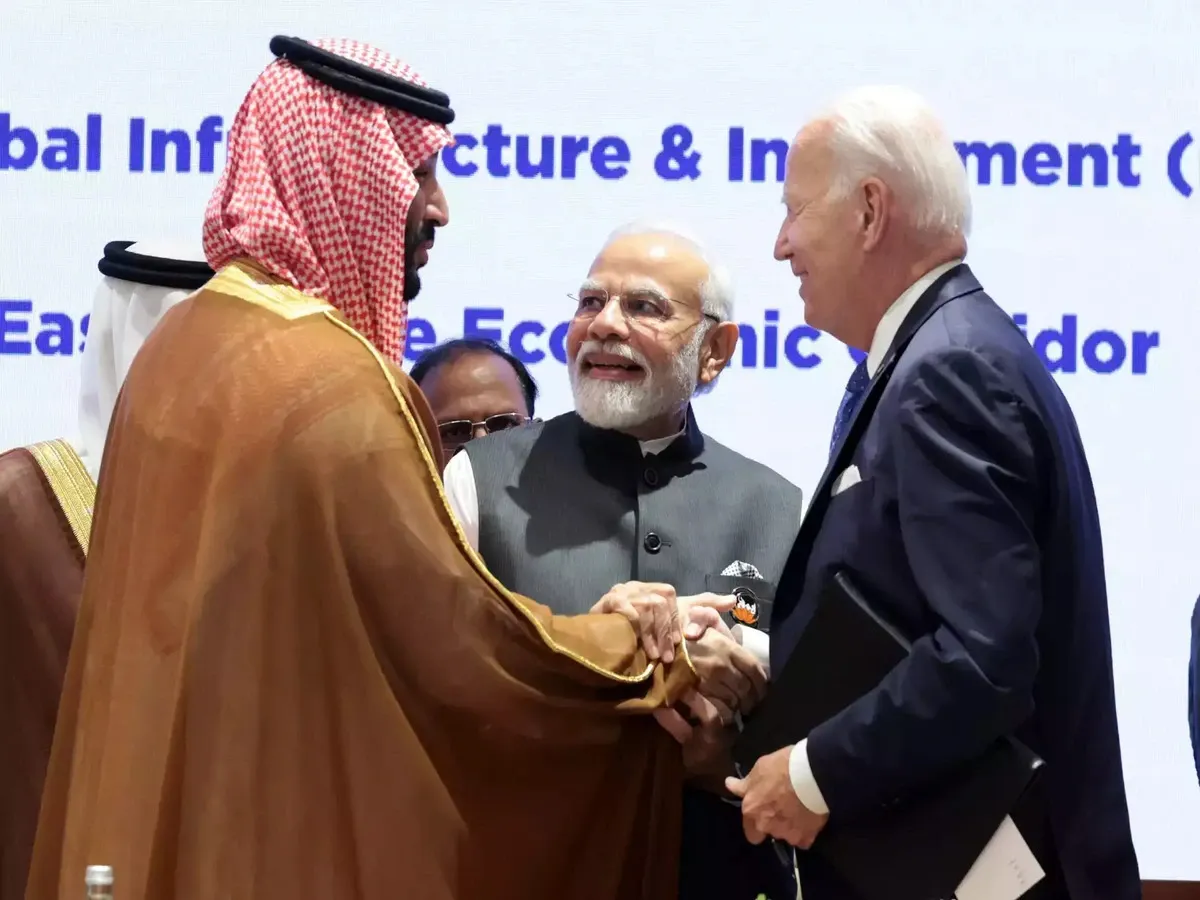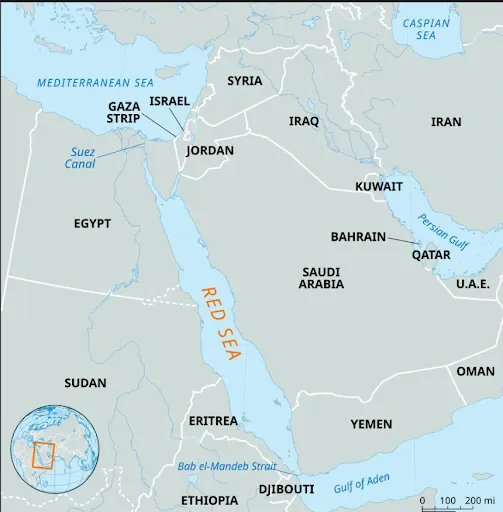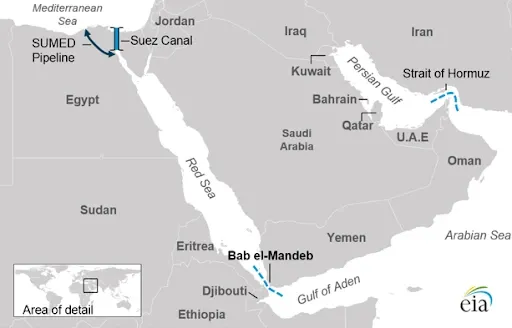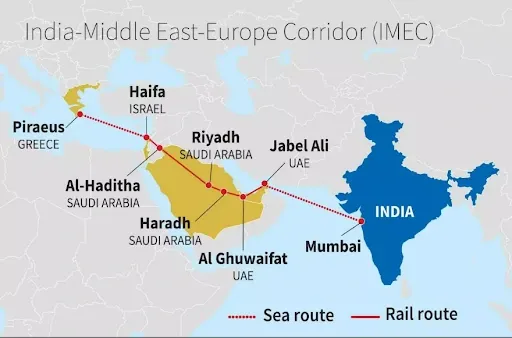Upstox Originals
Will the IMEC trade corridor fuel India’s global trade ambitions?

7 min read | Updated on March 26, 2025, 11:15 IST
SUMMARY
The IMEC trade corridor would connect India, Middle East and Europe through a comprehensive transportation network of rail, road and sea routes. Will this new silk route be a game-changer for the Indian economy? Let’s find out.

Leaders from India, Middle East and Europe signed an MoU at the G20 Summit in New Delhi in September 2023.
This route involves sailing through the Red Sea, which has two critical choke points—the Bab-el-Mandeb Strait in the south and the Suez Canal in the north. These choke points are vulnerable to blockage due to their narrow passages and security threats.

Image Courtesy: Encyclopaedia Britannica, Inc.

Image Courtesy: U.S. Energy Information Administration
These issues have huge ramifications on trade between Asia and Europe. For instance, the Houthi attacks on the Red Sea alone are estimated to have caused a $30 billion hit on India’s exports. Further, the six-day blockage of the Suez Canal in March 2021, caused by the grounding of the container ship ‘Ever Given’, led to an estimated trade loss of $89 billion and disruptions in global supply chains.
What is the alternative?
The India-Middle East-Europe Economic Corridor (IMEC)! This new trade route will connect Asia and Europe via the Middle East through a sea-to-rail corridor.
It will have two separate corridors:
- Eastern corridor - connecting India to the Arabian Gulf
- Northern corridor - connecting the Arabian Gulf to Europe
Here’s how the IMEC trade corridor would work
A ship carrying goods from an Indian port will dock in Dubai in the first leg. From Dubai, the cargo will be quickly shifted onto a railway network. From there, it will travel through UAE, Saudi Arabia and Jordan, eventually reaching Haifa in Israel. From Haifa, the cargo will move to the ocean route where it will be loaded onto another ship that sails across the Mediterranean and ultimately reaches Greece in Europe.

Image Courtesy: Drishti IAS
The IMEC trade corridor will provide an alternative to the existing ocean route to Europe, which passes through the Arabian Sea, Gulf of Aden, Red Sea, Suez Canal and the Mediterranean Sea.
How does India benefit from IMEC?
The IMEC trade corridor is currently in the early stages of development, but once fully operationalised, it could be a game-changer for the Indian economy in several ways.
IMEC will also enhance India’s economic opportunities in the West and the East and strengthen its global position. It will increase India’s trade accessibility in the lucrative European and Middle East markets.
Furthermore, a robust transportation network and economic infrastructure development would boost India’s exports to the six Gulf Cooperation Council (GCC) countries and the EU. Through the IMEC, Indian companies, already active in these regions will get an opportunity to invest in building the missing infrastructure.
Moreover, greater economic integration can drive India’s development and foster diplomatic and political goodwill, making it more attractive for investment—essential for economic growth.
The IMEC trade corridor will also help India establish itself as a key player in the global supply chains and trade routes. Moreover, the strengthened diplomatic ties can aid India create a more secure and stable supply chain.
That’s not all.
IMEC is a multimodal connectivity corridor that will include a railway link, a shipping link, an electricity cable, a high-speed data cable, and a hydrogen pipeline. This will improve digital connectivity between the participating nations and boost clean energy trade by exporting green hydrogen.
Here’s another thing.
IMEC would also act as a countermeasure to China’s Belt and Road Initiative (BRI) by offering a competing trade route.
While IMEC sounds like a perfect plan for India, it is not all that simple. There are several roadblocks to its realisation.
Let’s understand them.
Potential challenges for the IMEC
The biggest hurdle for the IMEC trade corridor is geopolitical risks. IMEC requires seamless cooperation and coordination among the involved nations, that don’t always see eye to eye, especially because of differing priorities and conflicting views on various economic and political matters.
Take for example, Israel and Saudi Arabia. While diplomatic ties between them have improved, they lack formal agreements, which could turn trade negotiations into a bureaucratic challenge. But that’s not it. The region is plagued by conflicts such as the civil unrest in Syria and Yemen, historical rivalry between Saudi Arabia and Iran, a strained relationship between Jordan and Israel, and threats to Israel from Iran-backed groups in Syria and Lebanon. Any geopolitical tensions could impede cooperation and slow down the IMEC’s progress.
Not to forget, potential opposition and competition from countries that are not on board. For instance, Egypt banks heavily on revenue from the Suez Canal. If IMEC redirects trade routes, Egypt could fight back with policy barriers.
With about $3 to $8 billion estimated cost of developing each route of the corridor, it is important to identify viable funding sources.
There is more to the story.
IMEC trade corridor is perceived to be a competitor to China’s BRI route. This rivalry can prove to be costly for India. Why you ask? Well, India is heavily reliant on Chinese-made containers. While India barely makes 10,000 to 30,000 containers locally, China produces 3 million shipping containers annually. Moreover, manufacturing a 40-foot container in India costs between $3,500 and $4,000, while in China it costs $2,500 to $3,000, further discouraging local production. Therefore, if China decides to restrict container supply to India, it could slow down the launch of the IMEC.
So yes, the IMEC trade corridor is grappling with challenges at the moment. To realise its goals, these challenges need to be addressed first.
Does this mean IMEC is destined to fail?
Not at all!
Despite the challenges, IMEC can prove to be a game-changer in boosting global trade and connectivity. Its successful implementation will likely redefine regional dynamics and lead to economic prosperity.
If member nations effectively tackle the geopolitical challenges and sort out the issues related to financing, the corridor could become a viable alternate strategic trade route to the existing ones.
By signing up you agree to Upstox’s Terms & Conditions
About The Author
Next Story
